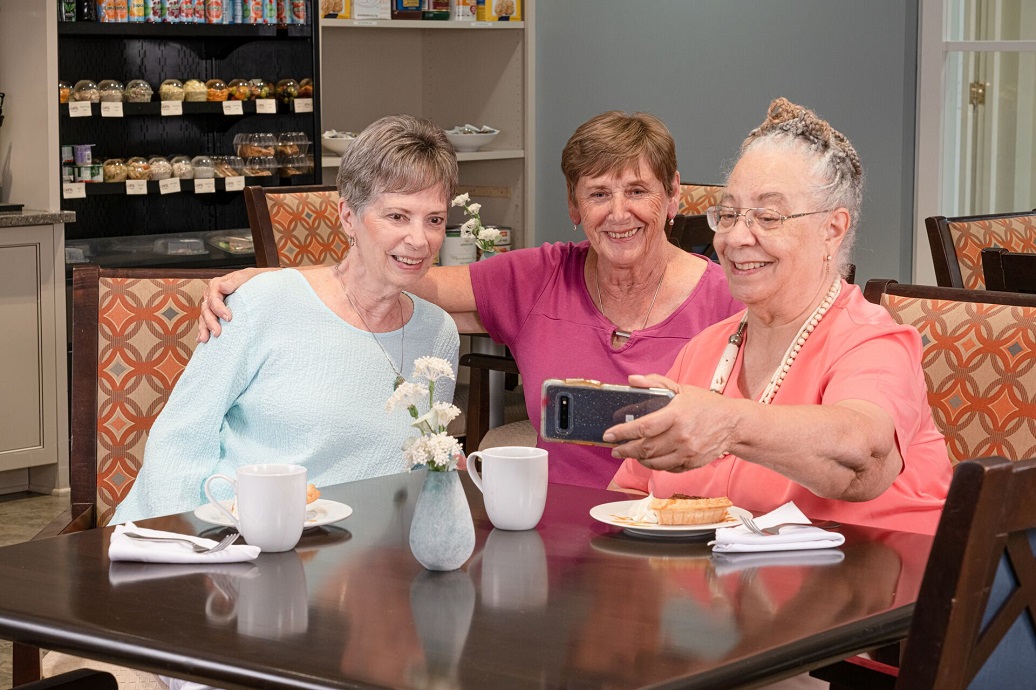
Trends in Retirement Communities Newport News, VA.
5 trends that may change your view of retirement communities.
Like any business, senior living communities exist to serve the needs and wants of their customers. As residents’ priorities change, so do retirement communities if they want to be successful.
The Baby Boomer generation has different expectations after retirement than their parents and grandparents. Maintaining an active, independent lifestyle. Continually learning and growing. Staying connected to the wider community. These are younger seniors’ expectations and they’re the catalyst for some of the trends driving change at senior living communities. To learn more about the trends shaping the future of senior living, read on.
- Greater use of technology — Technology no longer means just having communitywide access to Wi-Fi or a resident portal. That’s pretty much expected these days. And thanks to the pandemic, we’re all familiar with Zoom calls and FaceTime to help us stay connected with family, friends and co-workers. Virtual tours have also made visiting a community easier, especially for people who’d have to travel a long way to make the trip in person.
So what’s next on the horizon? Expect to see greater use of wearables that track activity, monitor vital signs and provide emergency alerts. Voice-activated speakers that can turn on the lights, unlock the door, remind you of birthdays, answer questions, play games, and order groceries will become more ubiquitous. Virtual reality usage will also expand beyond entertainment to improve cognitive health, allow you to travel virtually to different regions of the world, visit a childhood home (referred to as reminiscence therapy), swim with dolphins or go skydiving, and connect with loved ones.
- Emphasis on wellness — Adults are living longer and want to make the most of their golden years. The thought of sliding into old age and infirmity is anathema to today’s seniors. They want to stay active and continue leading fulfilling lives. It’s why retirement communities are moving away from a care-first mindset and toward a wellness lifestyle — with options for care available should the need arise. According to the International Council on Aging, five types of wellness activities will increase within communities:
- Continuing education/lifelong learning
- Exercise (instructor-led and tech-based)
- Health education and disease management
- Food and nutrition education/preparation
At The Chesapeake, wellness has always been a priority, though we call it a Vibrance lifestyle. Personalized fitness programs, Senior Olympics, glass-fusing classes, TED Talks, symphony performances, farm-to-table dishes, and more are all designed to help residents flourish.
- A fresh approach to dining — Retirement communities have come a long way from the days of cafeteria-style food. They’re stepping up their dining options with more choices and more venues. They’re hiring top-caliber chefs to head their kitchens, embracing farm-to-table cuisine, and collaborating with residents to ensure they’re serving up what residents want and need. One growing trend among Baby Boomers is an interest in vegan and flexitarian diets.
Venues are also being re-imagined to create a more intimate and comfortable atmosphere. Expansive windows let in natural light and scenery. Living room-style seating areas are replacing some of the standard table and four chairs setups. Coffee shops, pubs, cafes, and expanded outdoor dining spaces are elevating the dining experience for residents. As the expectations of seniors evolve, so will the dining options at senior living communities.
- Better access to health care — Many senior living communities have implemented on-site health care clinics that provide routine exams and urgent care for daily health concerns. Podiatrists, dentists and audiologists are common visitors at many retirement communities, along with primary care physicians. When it comes to health care concerns, a retirement community may be the best place to be.
When COVID-19 showed up in 2020, for example, senior living communities recognized the risk and immediately took proactive steps: increasing cleaning precautions, screening staff, requiring masks, starting meal deliveries, and stopping group activities. When the vaccine became available, residents were among the first adults to receive them. Everything was arranged for them; all they had to do was roll up their sleeves.
- Community involvement and volunteerism — Doing something meaningful in your retirement years is vitally important. The cultivation of community activism and volunteer opportunities meets that need head-on. Communities have taken proactive steps to involve seniors in the broader community, create more diverse social opportunities, and provide a sense of purpose in residents’ lives.
At The Chesapeake, for example, residents can participate in any number of group activities, including our community chorus or wine club, as well as hospitality, worship, dining, and resident council committees. Our residents also give back by participating in food bank drives and blood drives, and volunteering at area hospitals, animal shelters and museums. Chicks with Sticks is another volunteer group that makes baby blankets and caps for newborns at local hospitals, quilts to send overseas, blankets for the SPCA, and more.
See what’s new at The Chesapeake.
If you haven’t seen the dining renovations at The Chesapeake, you’re in for a treat. Residents can enjoy their morning coffee or a glass of wine before dinner by the fireplace in the new Windjammer lounge; order from the bistro menu in the new Regatta Grille; or be served cooked-to-order options in the formal Mariners Room.
The renovations are just one example of how our community continues to adapt to better serve the needs and wishes of our residents. That includes the many veterans who’ve made The Chesapeake their home. We’ll be honoring them on Veterans Day this November. To learn how you can honor the veterans in your life, check out our blog post, “How to Honor Veterans Any Day.” For more information about our continuing care retirement community, use the contact us form below. We’d love to hear from you.

